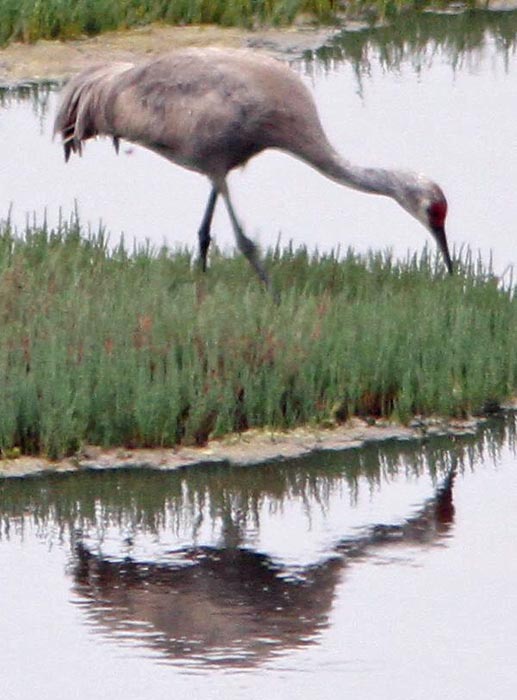| These highlights chronicle the year 2014. Created incrementally as new photos were available, the year runs generally "backwards" on this page. The abbreviation "MTY" means "Monterey County" in the text below. Text by Don Roberson. Photos on this page are copyrighted by the photographers to whom they are attributed, and may not be reproduced in any form (including other web sites) without the express consent of the photographer. | ||||
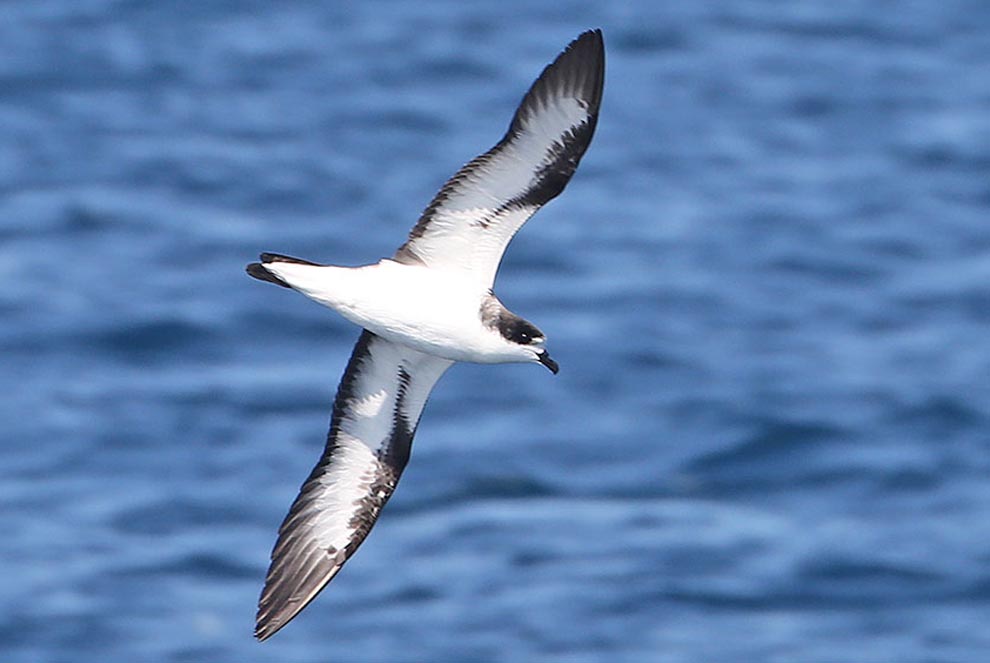 |
||||
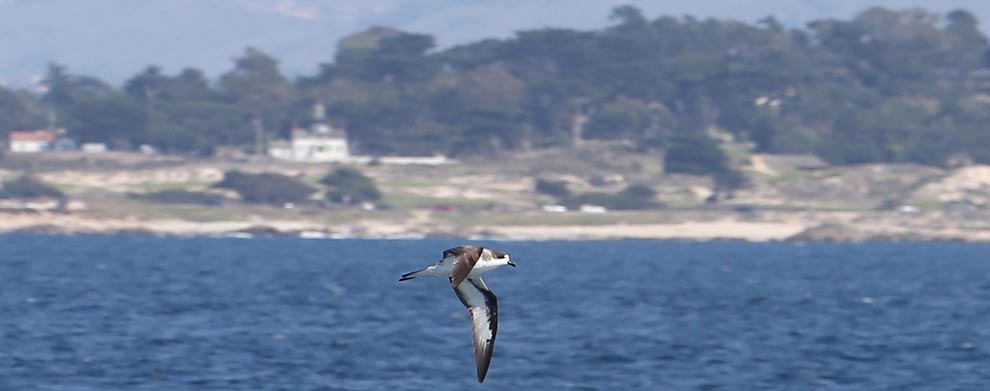 |
||||
Warm-water conditions offshore – a possible precursor to an El Niño — produced some warm-water seabirds and some great sea-watching from Pt. Pinos (more on that below). But by far the most astonishing bird locally was this beautifully-photographed Hawaiian Petrel, observed on 25 August by a group of British naturalists on a whale-watching trip just barely off Pt. Pinos (you can see the Pt. Pinos Lighthouse in the background of the bottom of the two photos above, © Peter J. Dunn). There are now a half-dozen records in MTY waters offshore, but previously only one had been this near to shore: one seen by Blake Matheson from Pt. Pinos on 11 May 2014 (see that highlight page, half-way down). Ever since the first two-dozen Black-vented Shearwaters were seen from Pt. Pinos on 19 July (D. Roberson), there has been a huge influx of hundreds of these warm-water seabirds into Monterey Bay (e.g., 5 in the photo below © D. Roberson). They have often been easily viewed at kelp line at Pt. Pinos, and sometimes joined by up to 15,000 Sooty Shearwaters. Among these flocks, at least 11 Manx Shearwaters have been seen (at least 8 from shore, 3 offshore) between 19 July- 29 August. Single Craveri's Murrelet were seen from Pt. Pinos 15 July (Brian Sullivan) and 1 August (D. Roberson), and more offshore. All this brings hope for more warm-water seabirds (and boobies or frigatebirds?) this fall. |
||||
 |
||||
| The last week of August 2014 produced the first of vagrant eastern landbirds: male American Redstart at Carmel R. mouth (24-30 Aug, B.T. Matheson +) and Ryan Ranch (Cooper Scollan, nice photo below left © Gary Woods); Northern Waterthrush (2 at Carmel R. mouth 29-30 Aug, Rita Carratello +, 2 at Laguna Grande 29-30 Aug, Jeff Barnum +), and, much rarer, a Blackburnian Warbler (R. Carratello) and a Prairie Warbler (D. Roberson, R. Carratello) on 27 Aug (the latter photographed © Sandra Bear). Both the Blackburnian and the Prairie are MTY's first records of August, and the earliest ever for fall migrants of these species here. | ||||
|
||||
| Among shorebirds in August were the usual very small smattering of juvenal-plumaged Semipalmated Sandpipers that ranged from 'classic' scaly-backed individuals (below left, near Salinas, found by D. Roberson, photo 25 Aug © Rick Fournier) to an unusually 'bright' bird (below right, Pt. Joe, found by Blake Matheson 26 Aug, photo © D. Roberson). The latter bird produced inquiries across two continents about the possibility of rare stints (see a brief discussion with photo comparisons elsewhere on this site). | ||||
|
||||
|
||||
|
||||
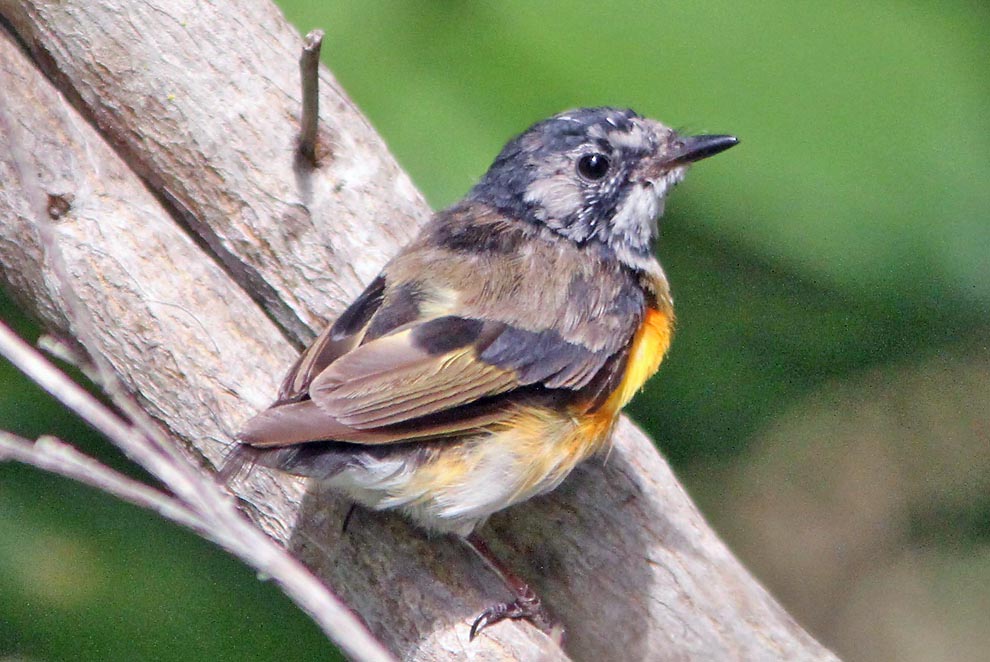 |
||||
Rita Carratello found this first-summer American Redstart (above, photo © D. Roberson) in Hatton Canyon, Carmel, on 19 July. When first discovered it had two remaining rectrices, but while she watched it preen, one of the tail feathers fell out. Next time she saw it (as above) it was tail-less, so it is in full active molt at the moment (and won't be going anywhere soon). It's fascinating to compare the new black feathers on head, upper back, and greater coverts to the year-old and worn-out brown or white ones. The lack of a tail makes it look like an exotic tropical gnateater or tody-flycatcher!
|
||||
| The 3rd week of July also proved to be a good time for sea-watching off Pt. Pinos. From at least 17-20 July, tens of thousands of Sooty Shearwaters were just off the Point all day (photo below 19 July, D. Roberson), where flocks were apparently sleeping at night. On 15 July, a Craveris' Murrelet was seen in flight past the Point (Brian Sullivan). On 19 July, several dozen Black-vented Shearwaters arrived in Monterey Bay, and with them were two close-to-shore Manx Shearwaters (D. Roberson, R. Carratello). This is like El Niño years for Black-vented Shearwater -- normally a species that arrives sometime between late September and November in "normal" years -- but the first of the season were as early as 29 May 1996, 29 June 1985, 7 July 1997, and 27 July 1991 back in those 'warm-water' years. Rollo Beck had them from 22 July back in the early 20th century. This suggests that we are experiencing El Niño conditions for seabirds. Later on 19 July, a basic-plumaged (or perhaps first-summer) Royal Tern flew west past Pt. Pinos (D. Roberson, R. Carratello). This is the first Royal Tern in Monterey Bay since the warm water decade of the 1980s. | ||||
 |
||||
 |
||||
Late June saw a huge influx of Heermann's Gulls (above, at Pebble Beach) and Brown Pelicans into Monterey Bay. These incursions occur annually but this one has very impressive numbers and feels somewhat early. In counterpoint, the tiny breeding colony of Heermann's Gulls atop a building near Roberts Lake, Seaside, had 7 recently-hatched downy young on 10 June (D. Roberson).
There is no published record for Surfbird in MTY during the two-month span between 10 May–10 July. Presumably the entire population moves way north, and the breeding grounds are on rocky alpine ridges, mostly in interior Alaska. Thus one at the Bird Rock parking area, Pebble Beach, on 29 June was of interest (photo left © Don Roberson). This is the first June record for this county. There are a couple June records in Santa Cruz Co., including one last year at Terrace Pt. on 23 June 2013 (Alex Rinkert et al.). The Pebble Beach individual (left) may be in first-alternate plumage, lacking the extensive rusty on scapulars and/or head that is found on many breeding plumaged Surfbirds. The age of first breeding is apparently not known (per Birds of North America on-line) so it may be that this individual is exactly one year old; went north towards the nesting grounds but did not breed; and then began its fall migration a few weeks early. |
||||
Almost all of the few MTY records have been between October-April — essentially late fall vagrants or occasional wintering individuals — but there are two late spring records in May: one in a Pacific Grove backyard 14-16 May 1999 (D. Roberson, R. Carratello), and the other in the mountains at the headwaters of Devils Creek, not far from Cone Peak, on 20-22 May 1982 (Vern Yadon, Ron Branson). The latter does suggest the possibility of summer birds in our mountains on rare occasions. Townsend's Solitaires breed as near as Mt. Pinos in southern California. |
||||
| Until I took the shot (just below) I'd never noticed how much portions of Estrada Marsh — just behind Kirby Park on Elkhorn Slough — look like the northern muskegs. But when one adds a Sandhill Crane (just below, middle left, and then the following photos), it sure felt like one might be in Alaska or the Northern Territories . . . | ||||
 |
||||
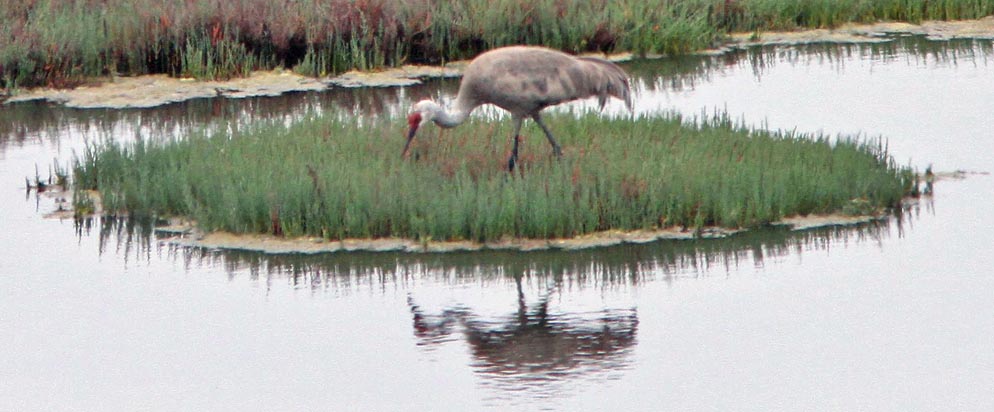 |
||||
There has never been a crane in MTY in June before. There's never even been one in May. Yet here it is, just as advertised. It was reported on 4 June by Sea Otter researchers (from a boat) and by Shirley Murphy. On 5 June, Rita Carratello and I first heard it calling, then almost immediately saw it flying over Kirby Park and landing in Estrada Marsh, where it spent the rest of the morning foraging actively (all photos © D. Roberson). The thing is — we cannot at this point say where it might be headed. Both nominate Grus canadensis canadensis — which breeds in Alaska and northern Canada ["Little Brown Crane"] — and the larger breeding subspecies of the Great Basin, including northeast California [G. c. tabida, "Greater Sandhill Crane"] — winter in California's Central Valley. Without direct comparison, I'm currently unwilling to opine as to which subspecies this might represent. [Perhaps there are crane experts out there willing to do so?] It does have a nice red forecrown (bare skin) but the upper wing coverts looked quite worn, both in the photos and in flight. Do you want to hear something intriguing? Do you recall the female Snow Bunting that was at Pt. Pinos 23-26 May 2009? Detailed photo analysis proved that "our bird" on that ridiculous late date in May was actually the same individual that had been in San Diego just a couple of weeks earlier! (30 Apr-7 May 2009; see the paper by Peter Pyle and our own Brian Sullivan (2010) W. Birds 41: 261-265). Well, for what it is worth, a Sandhill Crane was photographed in flight leaving San Joaquin Reserve, Orange Co., California, on the afternoon of 1 June [eBird data]. Could this possibly be the same very, very late crane? Or could it be last year's wintering bird, which used the Moss Landing gull roost on occasion — just as this bird has done — returning on a very odd date? It was still present to the end of August. Amazing. |
||||
In the meantime, Black Skimmers had been appearing at Santa Cruz in early June, and one was on Elkhorn Slough on 4 June (fide
otter researcher). When Rita and I finally tired of watching and
photographing the crane on 5 June, we walked back over the railroad
tracks to Kirby Park's parking lot just in time to see four (!) Black Skimmers
winging their way up-slough (below © D. Roberson). This is a
rather high count for MTY, and it is interesting that all seem to be
adults. It seems pretty late in the season to be heading toward S.F.
Bay breeding colonies. There are a couple of prior counts of as many as
4 skimmers in June; the highest count ever was 6 at Pajaro River mouth
on 26 July 1997 (but we presume those would be returning fall
migrants). |
||||
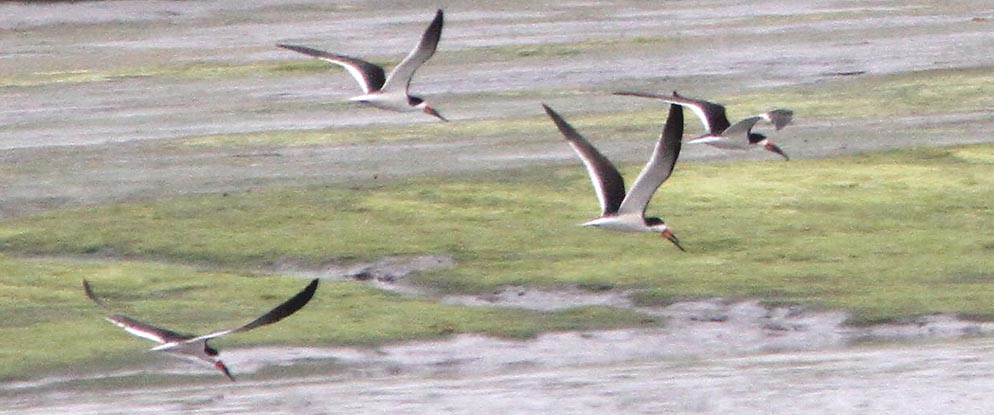 |
||||
|
|
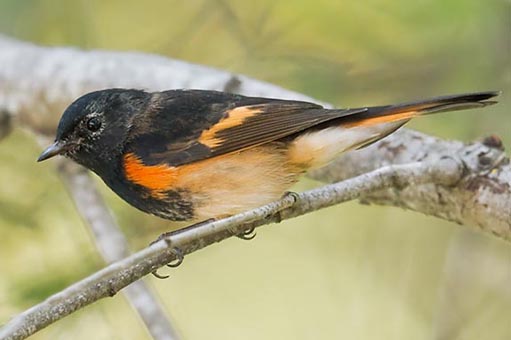

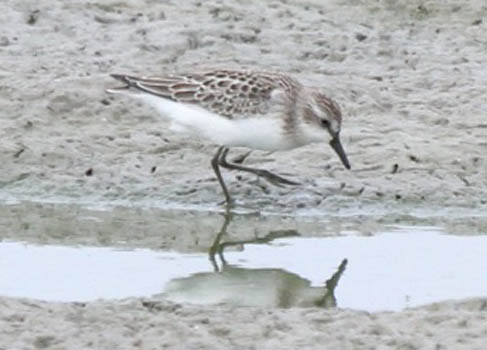
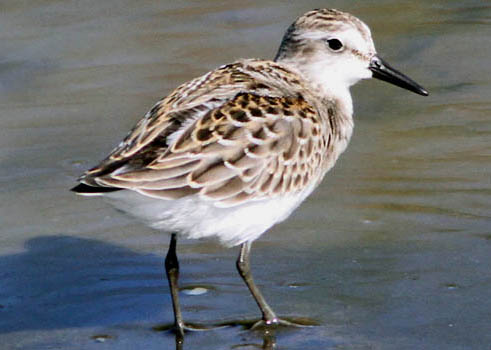

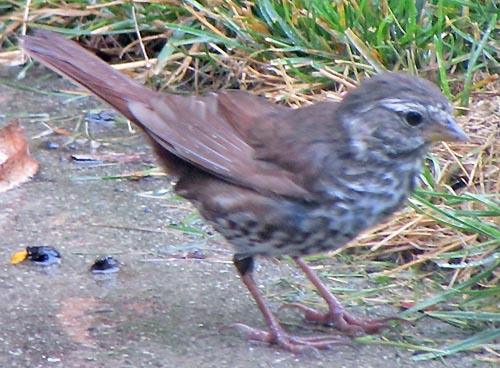
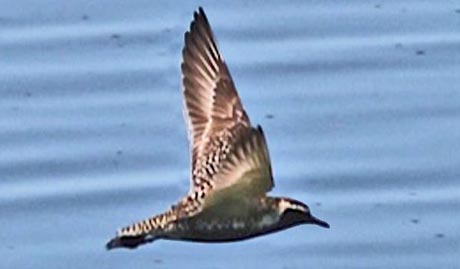
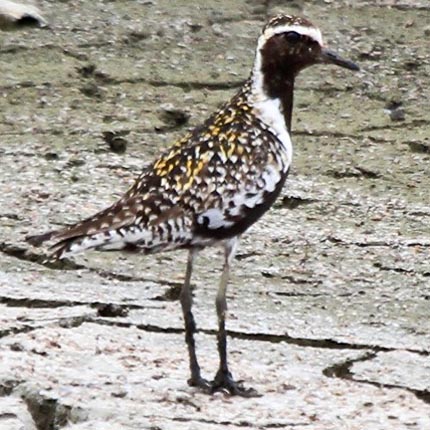
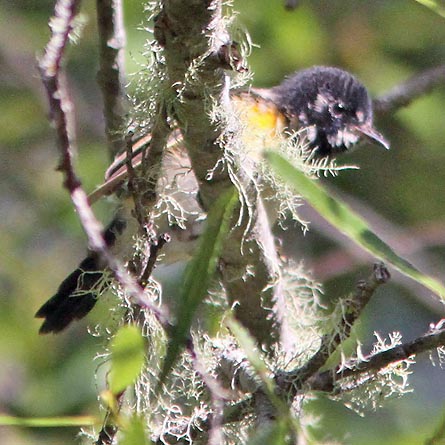
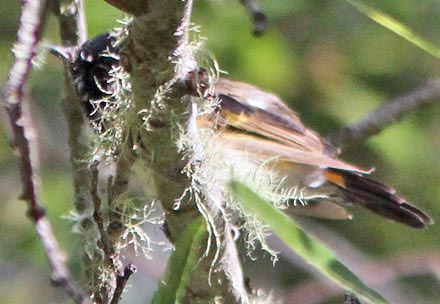
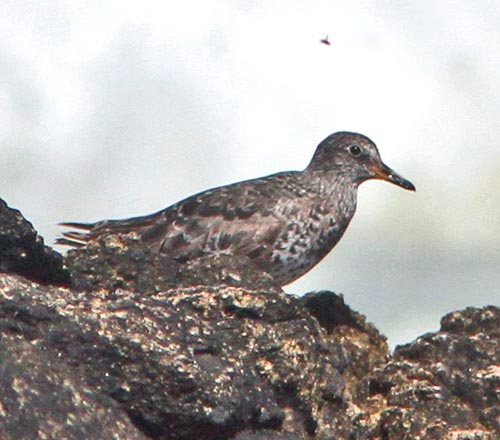 June
2014 was memorable for its out-of season bird occurrences — as
documented below, these include Surfbird, Townsend's Solitaire, and
Sandhill Crane!
June
2014 was memorable for its out-of season bird occurrences — as
documented below, these include Surfbird, Townsend's Solitaire, and
Sandhill Crane! 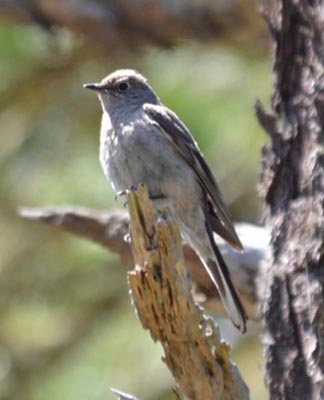
 Entirely out-of-season in June were two Townsend's Solitaires
in the northern Santa Lucia Range. Cooper Scollan had the first on
private property above Pt. Lobos (at only 200' elev.) on 20 June
(photos, right © C. Scollan). The second was a singing bird, heard
multiple times but not seen, along Skinner Ridge above Bottchers Gap,
at perhaps 2200' elev., on 22 June (Carole & Larry Rose).
Entirely out-of-season in June were two Townsend's Solitaires
in the northern Santa Lucia Range. Cooper Scollan had the first on
private property above Pt. Lobos (at only 200' elev.) on 20 June
(photos, right © C. Scollan). The second was a singing bird, heard
multiple times but not seen, along Skinner Ridge above Bottchers Gap,
at perhaps 2200' elev., on 22 June (Carole & Larry Rose). 